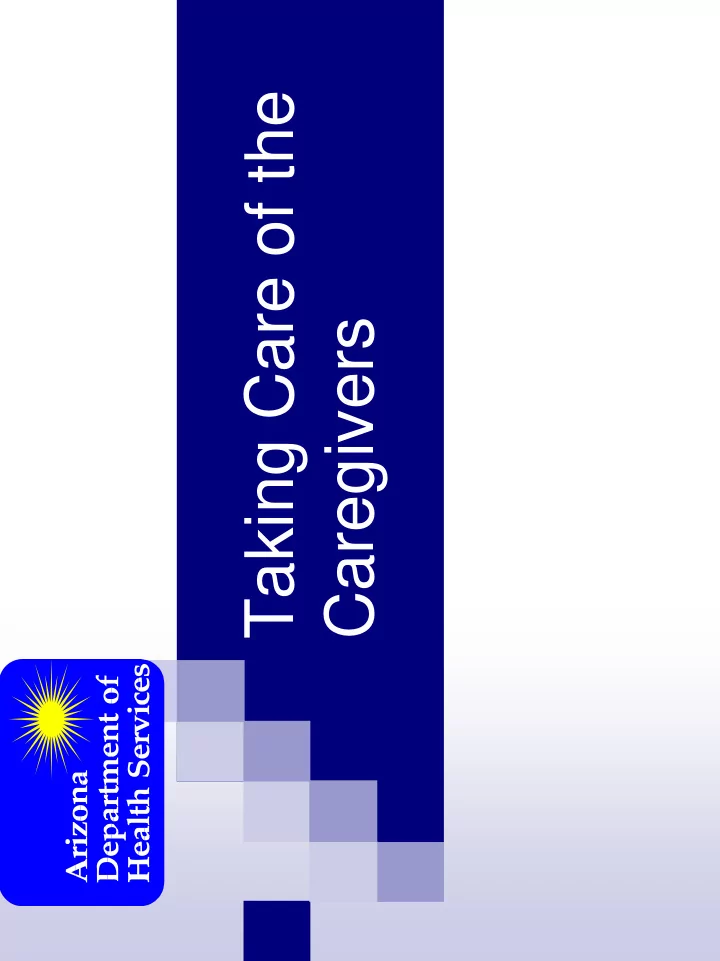

Taking Care of the Caregivers
Purpose � Educate ADHS responders to a disaster about: � critical incident stress. � compassion fatigue. � the types of crisis intervention services that will be utilized. � the importance of self-care. � the resources available to them.
Definitions � Stress - a state of physical and psychological arousal � Eustress - the term applied to stress as a positive motivating force; it may lead to increased health and performance. (Everly, 1994) � Distress - the term applied to stress as a negative dysfunctional force; it may lead to disease and erosion of health. (Everly, 1994)
Distress Reactions � Physical*: elevated heart rate and BP, rapid breathing, somatic pains, profuse sweating, vertigo, gastrointestinal distress, shock symptoms (ALOC) � Cognitive: difficulty remembering, can’t concentrate, intrusive images, nightmares, hyper-vigilance, confused thinking, paranoid
Distress Reactions � Emotional: emotional shock, sudden outbursts, anger, inability to control emotions, panic attacks, inappropriate emotional response, agitated � Behavioral: erratic movements, change in speech pattern, inability to rest, anti-social, intensified pacing, increased alcohol use, hyper-alert to environment.
Definitions � Stressor - a stimulus that causes or evokes, or is otherwise highly associates with the stress response. (Everly, 1994) � Stress response - the sum total of “wear and tear” on the body. (Selye) � Target organs - the part of the body or mind that is the “target” of the stress response and which develops signs and symptoms of over arousal. (Everly, 1994)
Definitions � Critical Incident - any event which has sufficient power to overwhelm an individual’s usual ability to cope. � A crisis is REAL to the person experiencing it. � ANYONE can have crisis at ANYTIME
Definitions � Community trauma – a blow to the tissues of social life that damages the bonds linking people together and impairs the prevailing sense of community. (Kai Erikson) � Compassion Stress – the natural consequent behaviors and emotions resulting from knowing about a traumatizing event experienced by another. (Figley, 2006)
Definitions � Compassion Fatigue – a state of tension and preoccupation with traumatized individuals by: � Re-experiencing the traumatic events � Avoidance /numbing of reminders, and � Persistent arousal. (Figley, 2006)
Definitions � Compassion Trap – the inability to let go of the thoughts, feelings, and emotions useful in helping another, long after they are useful. (Figley, 2006)
Factors Contributing to Compassion Stress Management (Figley, 2001) � Emotional Contagion is experiencing the feelings of the suffering as a function of exposure to the sufferer. � Empathic Concern is the motivation to respond to people in need. � Empathic Ability is the aptitude for noticing the pain of others.
Factors Contributing to Compassion Stress Management (Figley, 2001) � Empathic Response is the extent to which the helper makes an effort to reduce the suffering of the sufferer. � Disengagement is the extent to which the helper can distance himself or herself from the ongoing misery of the traumatized person.
Factors Contributing to Compassion Stress Management (Figley, 2001) � Sense of Achievement is the extent to which the helper is satisfied with his or her efforts to help the client/sufferer. � Compassion Stress is the demand for action to relieve the suffering of others. � Prolonged Exposure is the on-going sense of responsibility for the care of the suffering, over a protracted period of time.
Factors Contributing to Compassion Stress Management (Figley, 2001) � Traumatic Recollections are memories that trigger the symptoms of PTDS and associated reactions. � Life Disruption is the unexpected changes in schedule, routine, and managing life’s responsibilities that demand attention.
Definitions � Cumulative stress – stress arousal that slowly builds up over time and sometimes leads to a condition of “burnout”. (Everly, 1994) � Burnout – state of mental and physical exhaustion. It has three phases: 1) Stress arousal 2) Energy Conservation 3) Exhaustion
Critical Incident Stress Management (CISM) � A comprehensive, integrated, system, and multi-tactic crisis intervention approach to manage critical incident stress after traumatic events.
CISM Interventions � Pre-event preparation: preparing the worker for the stressors of the job � Individual intervention � Demobilization: a large group intervention used at the end of deployment of responders
CISM Interventions � Crisis Management Briefing: a large or small group intervention to provide information, dispel rumors, provide resources. � Respite center: for large on-going operations, provides refreshments, and social support � Defusing: a small group intervention provided within 12 hours of the incident
CISM Interventions � Critical Incident Stress Debriefing (CISD): a small group process for very traumatic, distressing events � Family Crisis Intervention: provided for the families of the responders � Pastoral Crisis Intervention: faith based support for those struggling with a crisis of faith issue(s)
Standards of Self Care (Adapted from Academy of Traumatology – Green Cross) � It is unethical not to attend to your self care as a practitioner because sufficient self care prevents harming those we serve. It is your responsibility to take care of yourself and no situation or person can justify neglecting it. � Seek, find, and remember appreciation from supervisors and clients and make it known that you wish to be recognized for your service.
Standards of Self Care (Adapted from Academy of Traumatology – Green Cross) � Make a commitment to: let go of work in off hours; acquire adequate rest; relax in doing things you enjoy; exercise; proper nutrition; talk to someone about your experience.
Follow-up Resources � The State of Arizona, through their Employee Assistance Program, can provide follow-up counseling services.
Recommend
More recommend